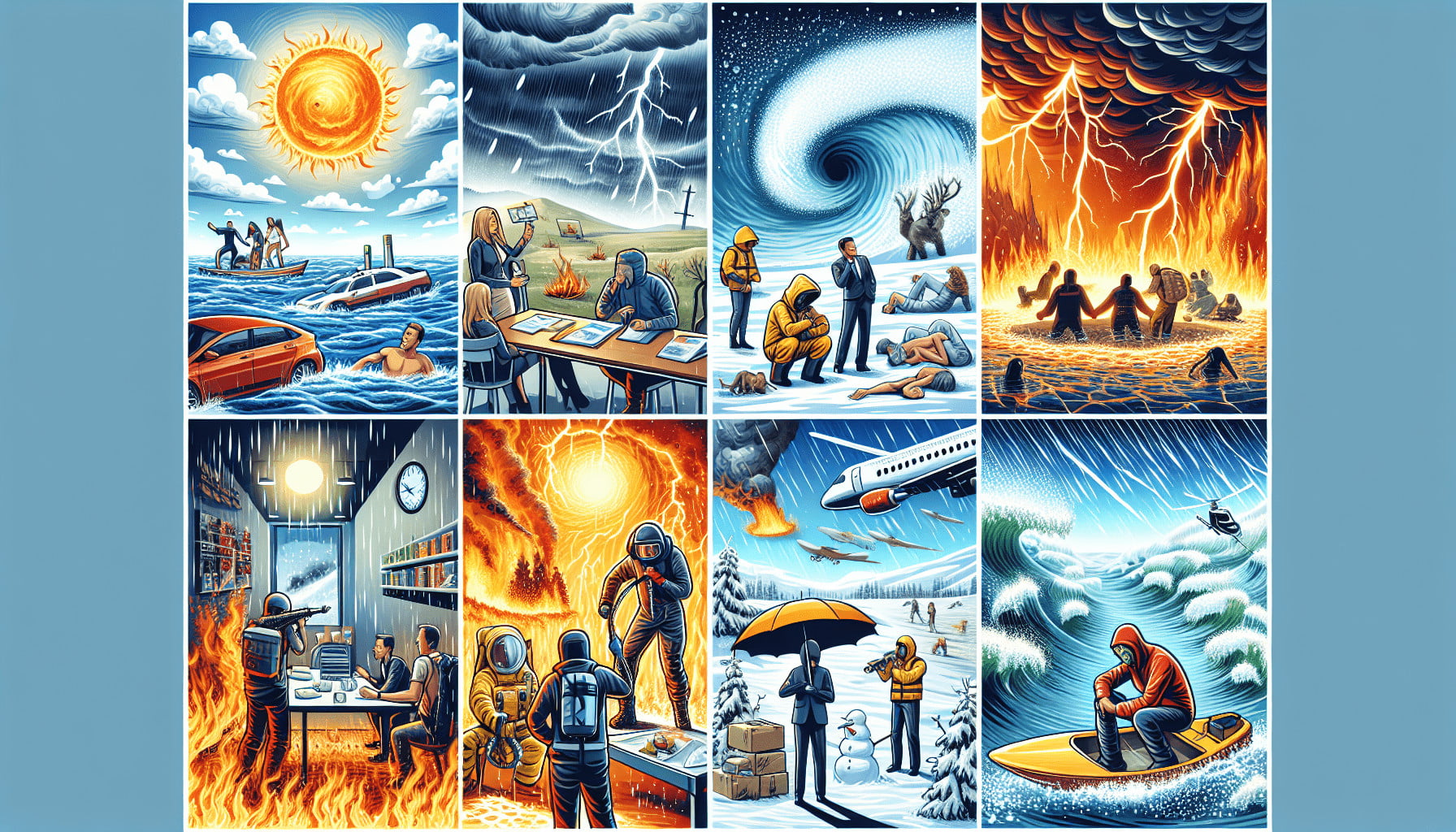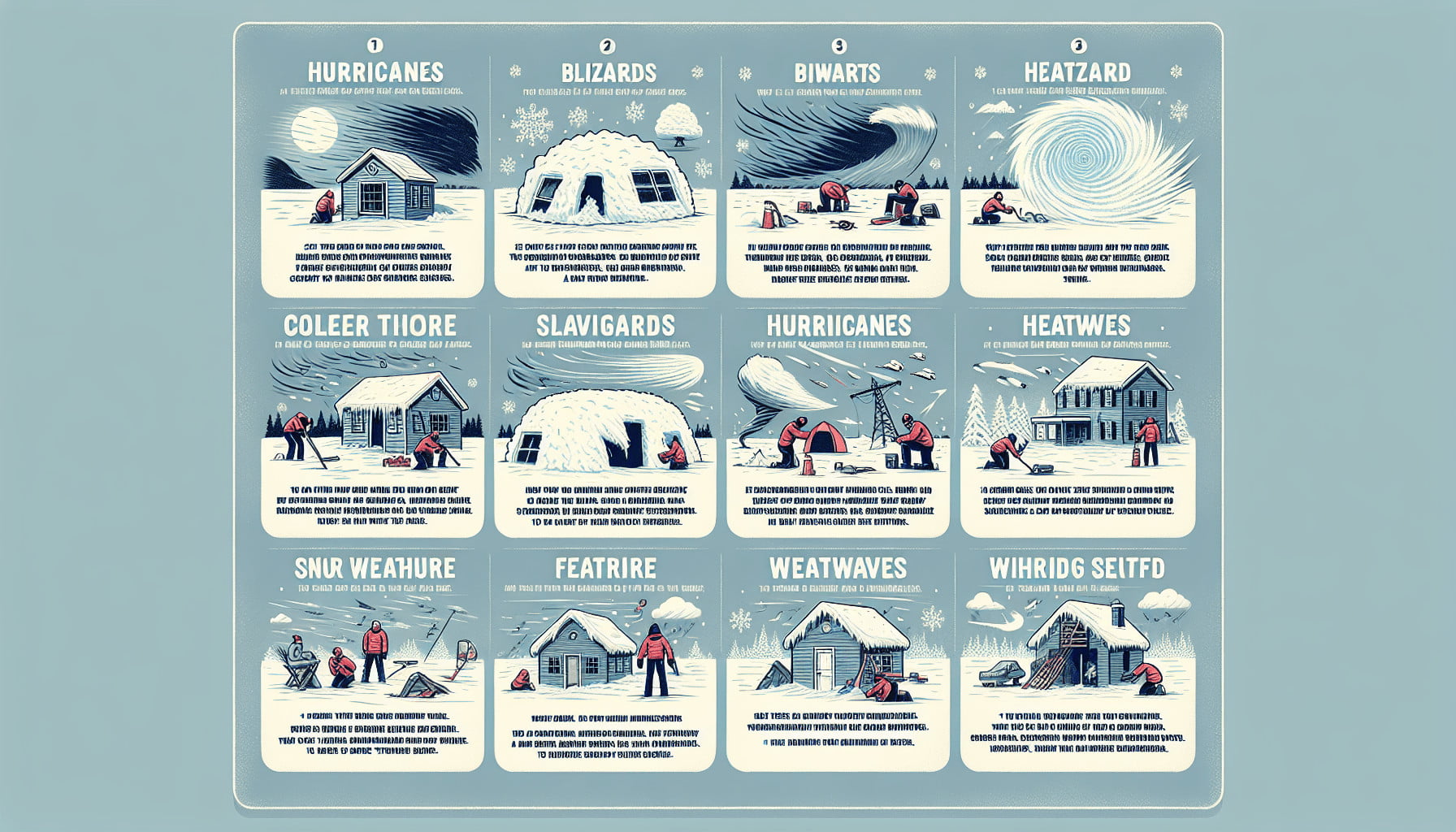Extreme weather conditions can be unpredictable and challenging to navigate, but with the right knowledge and preparation, you can ensure your safety and survival. From scorching heatwaves to freezing blizzards, this article will provide you with the top 10 survival tips to help you weather any storm. Whether you find yourself in the scorching desert or the freezing wilderness, these tips will equip you with the skills and tools needed to stay safe and thrive in even the most extreme weather conditions. So grab your umbrella or parka, and let’s dive into these essential survival tips!

Emergency Preparedness
Being prepared for emergencies is crucial for keeping yourself and your loved ones safe. One of the first steps in emergency preparedness is to create an emergency kit. This kit should include essentials like bottled water, non-perishable food items, a flashlight, batteries, a first aid kit, extra medications, and a multi-purpose tool. By having these items readily available, you can be better equipped to handle unexpected situations.
In addition to an emergency kit, it is important to stock up on non-perishable food and water. In times of crisis, access to food and clean drinking water may be limited. By having a sufficient supply of non-perishable food items like canned goods, granola bars, and dried fruits, you can ensure that you and your family will have enough to eat. Similarly, storing an ample amount of bottled water is crucial for staying hydrated during emergencies.
Developing an emergency communication plan is also essential. In a chaotic situation, it can be difficult to find and communicate with your loved ones. By establishing a communication plan, you can have a designated meeting place and a set of contact numbers to reach out to. This way, you can ensure that everyone is accounted for and in a safe location.
Extreme Cold Weather
During extreme cold weather conditions, it is important to dress in layers. Layering your clothing allows you to adjust your level of insulation based on the temperature. Start with a base layer that is moisture-wicking to keep your body dry, followed by an insulating layer like a fleece jacket, and top it off with a waterproof and windproof outer layer. This way, you can easily add or remove layers as needed to stay comfortable and warm.
Protecting your extremities is crucial in extreme cold weather. Make sure to wear insulated gloves or mittens to keep your hands warm, and wear thermal socks and waterproof boots to protect your feet from frostbite. Additionally, wearing a hat and a scarf can help prevent heat loss from your head and neck.
Keeping your home warm during cold weather is essential for your safety and comfort. Make sure to check that your heating system is working properly and have it serviced regularly. Insulate your windows and doors to prevent drafts, and use weatherstripping to seal any gaps. It is also a good idea to keep emergency blankets and sleeping bags on hand in case of power outages or heating system failures.
Extreme Hot Weather
Staying hydrated is of utmost importance during extreme hot weather conditions. Drink plenty of water throughout the day, even if you do not feel thirsty. Avoid consuming excessive amounts of caffeine or alcohol as they can contribute to dehydration. If you are engaging in outdoor activities, make sure to bring a water bottle with you and take regular breaks in shaded areas to rest and rehydrate.
When the temperature soars, seek shade and cool areas whenever possible. Avoid direct exposure to the sun, especially during the peak hours of the day when the sun’s rays are the strongest. If you do need to be outside, wear lightweight and breathable clothing that allows for air circulation and protects your skin from sunburn. Consider using a wide-brimmed hat or an umbrella to shield yourself from the sun.
During extreme hot weather, it is important to avoid strenuous activities, especially during the peak heat of the day. Engaging in intense physical exertion can put a tremendous strain on your body and increase the risk of heat-related illnesses, such as heatstroke. If you must engage in physical activity, try to schedule it for the cooler parts of the day and take frequent breaks to rest and cool down.
Tornadoes and Hurricanes
In areas prone to tornadoes and hurricanes, it is crucial to identify a safe room or shelter. This room should be located on the lowest level of your home, preferably without windows, and it should be reinforced for added protection. If you live in an area vulnerable to hurricanes, consider investing in hurricane shutters or plywood boards to protect your windows from strong winds and flying debris.
Staying informed with weather alerts is essential during tornadoes and hurricanes. Keep a battery-powered weather radio or a smartphone with a reliable weather app to receive real-time updates and warnings. Make sure to follow evacuation orders issued by local authorities and have a designated emergency meeting place in case you and your family members get separated.
Secure loose objects around your property to prevent them from becoming projectiles during a tornado or hurricane. Strong winds can cause significant damage by picking up and throwing objects. Store outdoor furniture, garden tools, and other loose items in a secure location or tie them down to prevent them from being blown away.

Floods
Creating an evacuation plan is crucial when living in an area prone to flooding. Identify the safest evacuation routes in your area and have a plan in place for how you will reach higher ground. Make sure to communicate this plan with your family members, so everyone knows what to do in case of a flood.
Storing important documents in waterproof containers is vital to protect them from water damage during floods. Keep copies of important documents like identification papers, insurance policies, and medical records in a sealed and waterproof folder. If possible, store them in a secure location or consider a digital backup for added safety.
During a flood, it is important to avoid walking through floodwaters, as they can be both deeper and swifter than they appear. Floodwaters can also contain hazardous materials, sewage, or debris that can pose a threat to your health. If you encounter a flooded area, it is best to turn around and find an alternate route to safety.
Wildfires
Creating a defensible space around your property is essential for protecting it from wildfires. Clear away any flammable debris, such as dead leaves, branches, and debris, from your yard. Trim overhanging tree branches and remove any dry vegetation that is too close to your home. This will help create a buffer zone that can reduce the risk of fire spreading to your property.
Monitoring and following evacuation orders is vital during wildfires. Stay updated on the latest information from local authorities and be prepared to evacuate if necessary. Have a packed emergency kit ready to grab and go, including essentials like food, water, medications, and important documents.
Learning basic fire safety measures can help protect you and your property during wildfires. Follow fire bans and avoid activities that can create sparks, such as operating power tools or outdoor grilling. Be cautious with campfires and ensure they are completely extinguished before leaving the area. Report any signs of a wildfire immediately to authorities to prevent its escalation.
Thunderstorms and Lightning
Seeking shelter in a sturdy building or vehicle is crucial during thunderstorms. Lightning can pose a significant risk to your safety, so it is important to find a place where you can take cover. Avoid seeking shelter under trees or in open areas, as they attract lightning. If you are caught outdoors and cannot find shelter, crouch down in a low-lying area and minimize your contact with the ground.
Staying away from tall objects and bodies of water is important during thunderstorms. Lightning is more likely to strike tall objects like trees and poles, as well as bodies of water. Avoid swimming, boating, or participating in water activities during thunderstorms. If you are in an open area, move to a lower area to minimize your risk of being struck by lightning.
During thunderstorms, it is advisable to avoid using electrical appliances or devices that are plugged into outlets. Lightning can cause power surges that can damage your appliances and put you at risk of electrical shock. Unplug sensitive electronics and appliances until the storm passes to minimize the risk of damage.
Blizzards and Snowstorms
During blizzards and snowstorms, it is best to stay indoors and avoid unnecessary travel. Blizzards can bring heavy snowfall, strong winds, and limited visibility, making driving extremely dangerous. If you must go outside, make sure to dress warmly and wear appropriate winter gear, such as a heavy coat, hat, gloves, and waterproof boots.
Preparing for power outages is essential during blizzards and snowstorms. Have a supply of flashlights, extra batteries, and a battery-powered radio on hand. Stock up on non-perishable food items and ensure you have enough bottled water to last several days. Consider installing a backup generator or alternative heating sources, such as a wood-burning stove, to keep your home warm in case of power failure.
Checking on vulnerable individuals in your community is important during blizzards and snowstorms. Elderly individuals, young children, and those with medical conditions may be especially susceptible to harsh weather conditions. Reach out to neighbors or family members who may need assistance and offer help if needed.
Drought
During periods of drought, it is important to conserve water. Limit your water usage by taking shorter showers, fixing any leaks in your plumbing, and using water-efficient appliances and fixtures. Consider collecting rainwater for watering plants and gardens, and avoid unnecessary water wastage, such as leaving taps running or over-watering your lawn.
Planting drought-resistant vegetation can help preserve water during droughts. Opt for native plants that are naturally adapted to the local climate and require less water to thrive. Mulch your garden beds to retain moisture and reduce evaporation, and consider installing drip irrigation systems that deliver water directly to the roots of your plants.
Monitoring water sources for your survival needs is essential during droughts. Stay informed about water restrictions in your area and follow any guidelines or regulations. Be mindful of your water consumption and store an adequate supply of drinking water in case access to clean water becomes limited.
Heatwaves
During heatwaves, it is best to stay indoors in air-conditioned spaces as much as possible. If you do not have access to air conditioning, consider spending time in public places such as shopping malls, libraries, or community centers that do. These places often provide cool environments where you can seek relief from the extreme heat.
Checking on elderly or vulnerable individuals is important during heatwaves. Older adults and those with certain medical conditions may be more susceptible to heat-related illnesses. Reach out to family members, friends, and neighbors who may need assistance, and make sure they have access to a cool environment and are staying hydrated.
Using cooling techniques like wet towels and fans can provide temporary relief during heatwaves. Wetting a towel with cool water and placing it on your forehead, neck, or wrists can help lower your body temperature. Electric fans or battery-operated fans can also provide a cooling breeze when air conditioning is not available.
